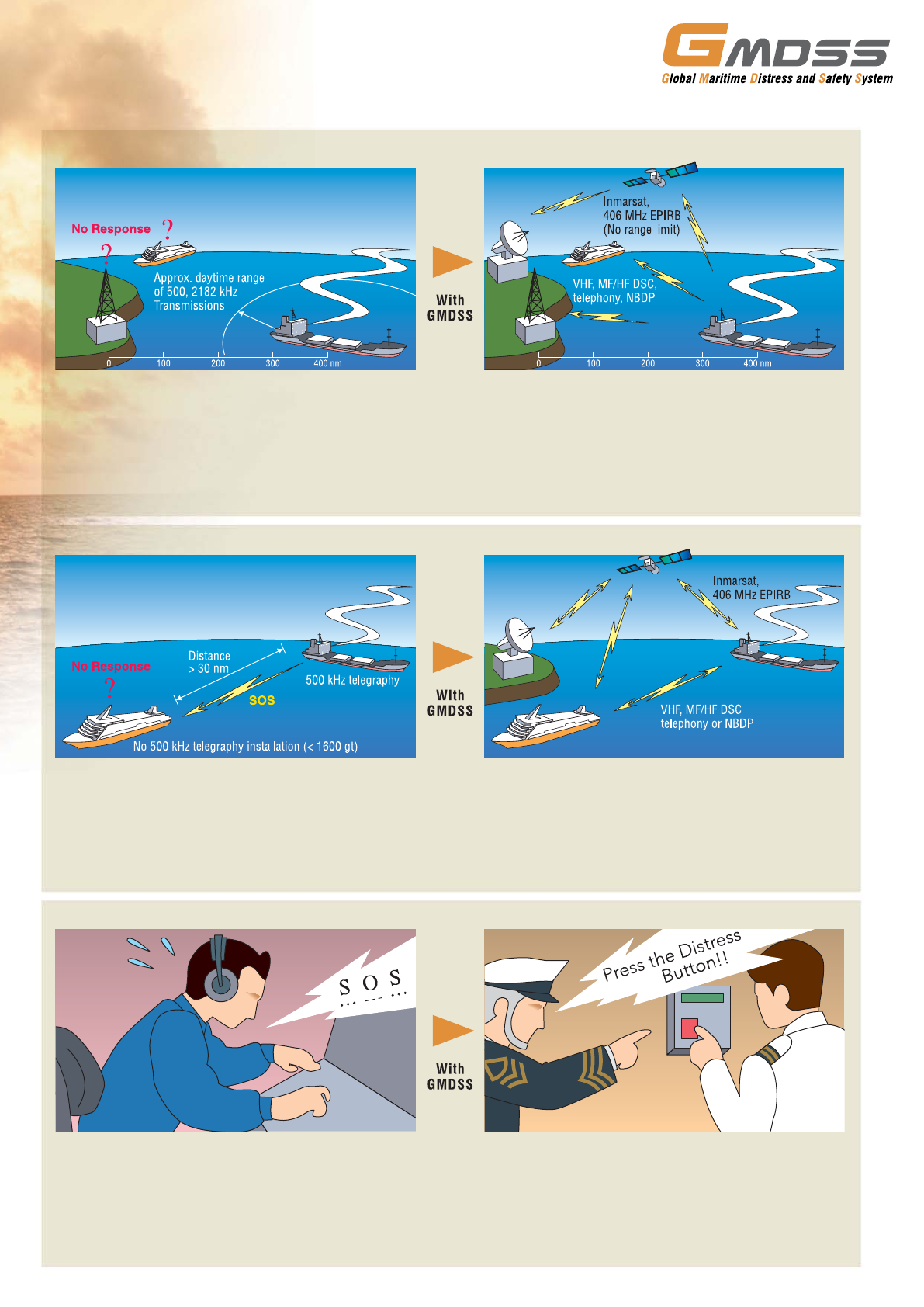
Sea Area
The radiotelephone
coverage of VHF coast
stations in which continuous
alerting by Digital Selective
Calling (DSC) is available.
Sea Area
The radiotelephone
coverage of MF coast
stations in which continuous
alerting by Digital Selective
Calling is available.
Sea Area
The coverage of Inmarsat
geostationary satellites.
Sea Area
Area outside A1, A2 and
A3, mostly sea area around
polar areas
GENERAL CONCEPT OF GMDSS
GENERAL CONCEPT OF GMDSS
Global Maritime Distress and Safety System (GMDSS) has been
developed by the maritime nations in the International Maritime
Organization (IMO) and is the result of their adoption of amendments
made in 1988 to the 1974 International Convention on the Safety of
Life at Sea (SOLAS).
Based on recent developments in maritime communications, such
as satellites and digital technology, GMDSS is designed to ensure
maximum availability of safety-related communication for all passenger
ships as well as for cargo vessels of 300 GT and upwards engaged in
international voyages.*
The goal of GMDSS is to virtually guarantee that complying vessels
will be able to communicate with an onshore station at any time,
from any location, in case of distress or to exchange safety-related
information.
*Ships below 300 gross tonnage as well as those that are not engaged in international
voyages are subject to the requirements of the administrations of their flag states.
SEA AREAS
GMDSS defines four sea areas based upon the location and capability of onshore-based communication facilities.
The definition of the Sea Areas for GMDSS is outlined below. Please refer to the illustrated layout of the European
area indicating the sea areas and coastal stations for quick reference.
Example: European GMDSS SEA AREAS
GMDSS Sea Areas
Medium Frequency (MF),
High Frequency (HF) and
Very High Frequency
(VHF) Coast Radio Station
Medium Frequency (MF)
and Very High Frequency
(VHF) Coast Radio Station
Very High Frequency
(VHF) Coast Radio Station
Comparison between old distress system and GMDSS
Reliance on ships in vicinity
Special skill to operate
Worldwide coverage
Simple and automatic operation
Equipment compatibility
Because of the inherently limited range of
transmission on the distress and calling
frequencies of 500 and 2182 kHz, which were
commonly used for that purpose, there was a
possibility that a call for assistance would not be
heard if other vessels and coastal stations were
outside the range.
It was only possible for a vessel in distress to ask
other vessels in the vicinity for assistance, due to
the limited range of communication means.
Worse, the communication incompatibility
between a telegraphy vessel and a telephony
vessel hindered subsequent Search and Rescue
operations.
Radio officers had to send distress calls in Morse
Code on 500 kHz through complicated operations,
which include: switching and/or adjusting the
transmitters. A successful distress attempt relied
heavily on the skill of the radio officers.
GMDSS vessels carry the communications
equipment appropriate for the Sea Area they are
operating, and have the means to transmit long-
range communication whenever necessary. This
means that a call for assistance can reach a
coastal station, and other ships at a far distance.
Since all GMDSS vessels carry standardized
equipment for the Sea Area, and they are
operating in the same frequencies, the
compatibility between the SAR coordinator at a
coastal station and a vessel is assured.
GMDSS equipment, on the other hand, provides
straightforward operation in time of emergency
simply by pressing the distress button on the VHF,
MF/HF DSC or Inmarsat MES. If this cannot be
done, a float-free EPIRB can transmit a distress
alert.
1
2














